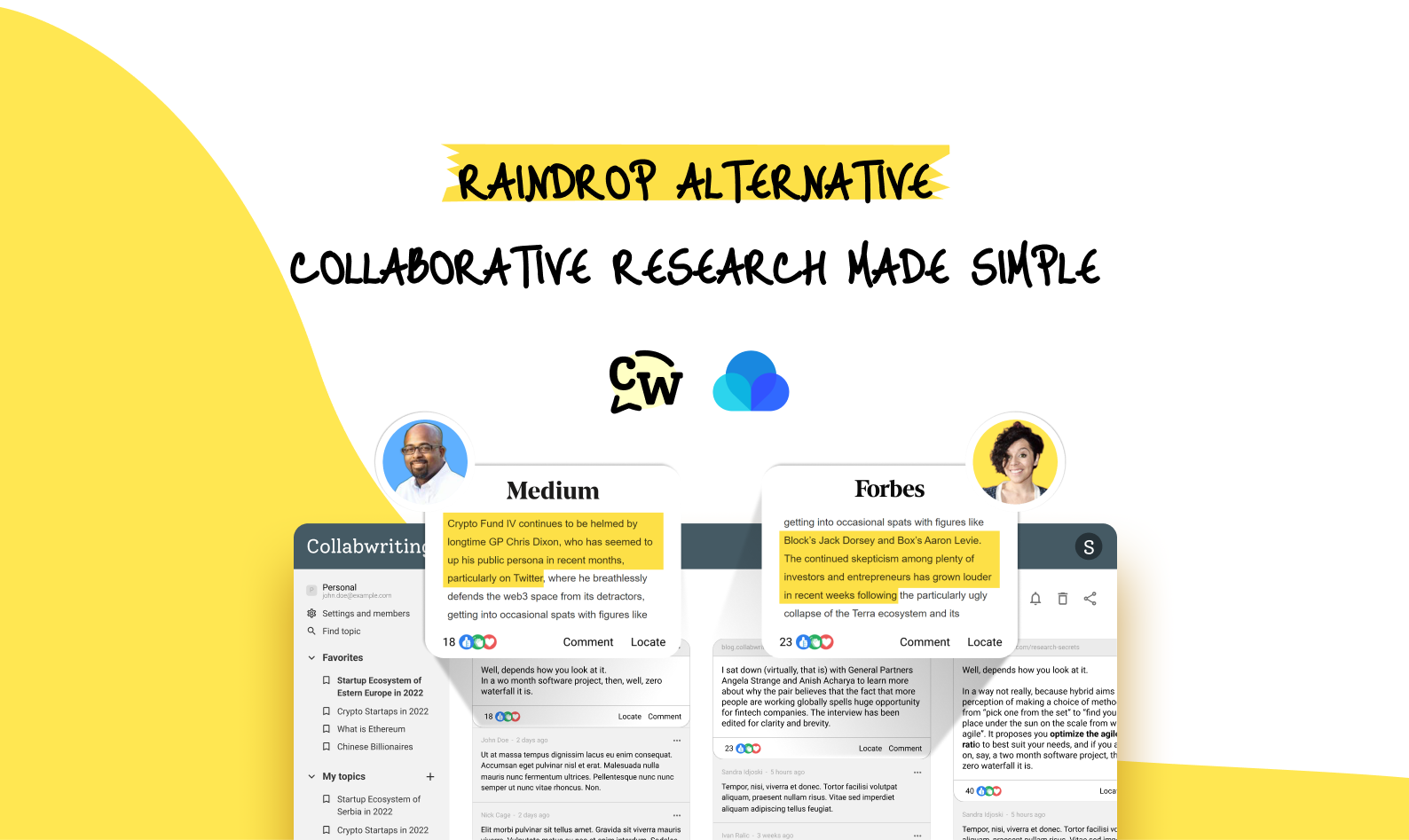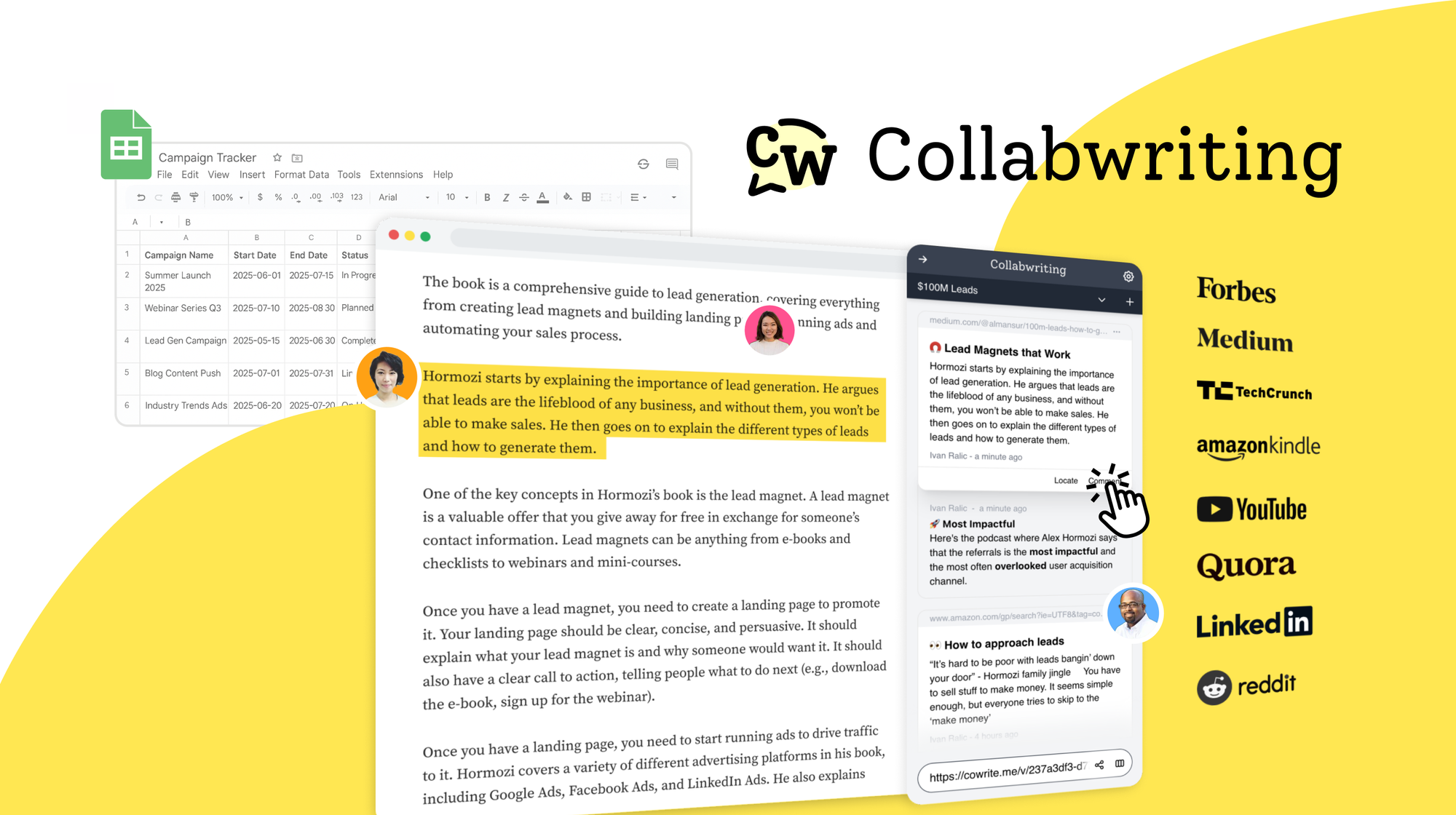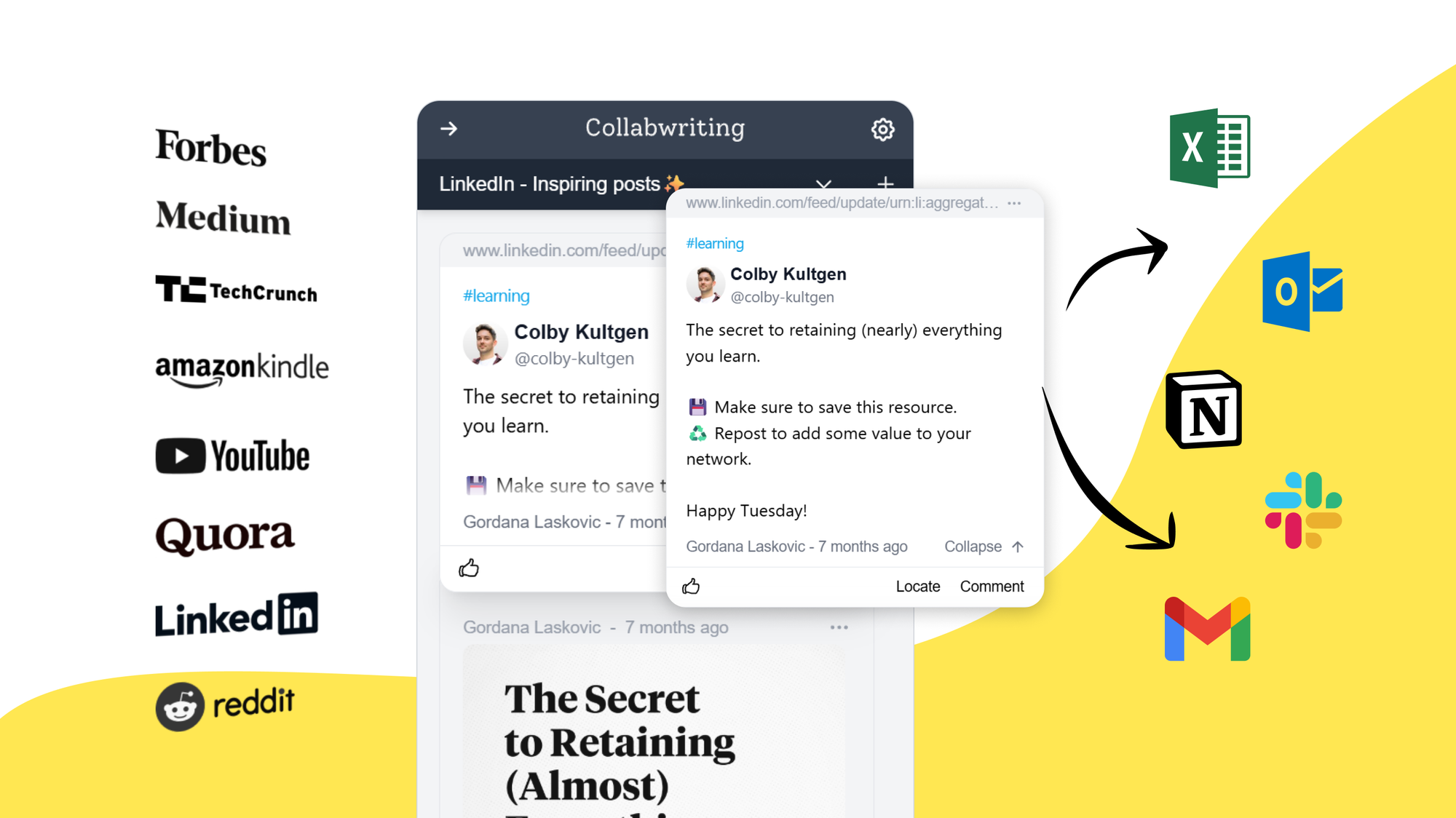Information never stops moving online.
One minute, you’re reading an article; the next, it’s already being shared across feeds, chats, and newsletters. Every claim, every statistic, every bold statement feels urgent to check - but there’s just too much, and the more you try to verify, the heavier it feels.
It’s exhausting. You scroll, open tabs, take notes, and still worry: Did I miss something? Did I check that source?
Verification is about more than logic. It’s about confidence. About finally closing your laptop without that anxiety that you forgot to check a single fact.
This guide shows you how to verify information online effectively and build credibility in research without burning out.
Using the R.E.A.L. method, practical verification techniques, and Collabwriting with its AI Chat agents, you can create a workflow that makes fact-checking thorough, organized, and collaborative, while giving you back your calm.
The Verification Workflow to Verify Information and Build Credibility in Research
Verification can easily become overwhelming when information is constantly streaming in from multiple sources. Randomly checking claims leaves you scattered, stressed, and unsure if you’ve covered everything. That’s why a structured approach is essential.
The R.E.A.L. method provides a clear, repeatable workflow that helps you stay on top of information and maintain trust in your research:
- Review - Start by carefully reading the claim. Make sure you understand exactly what is being asserted.
- Evaluate - Consider the source, author, and date. Look for credibility signals and any past reliability issues.
- Analyze - Break the claim into parts and verify each component with evidence.
- Link Back - Keep a clear trail of sources and notes to ensure nothing is lost or misinterpreted.
- Log & Share - Organize verified information into clusters for future reference or team collaboration.
Following these steps consistently allows you to confidently verify information and build credibility in research, without drowning in tabs, spreadsheets, and scattered notes.
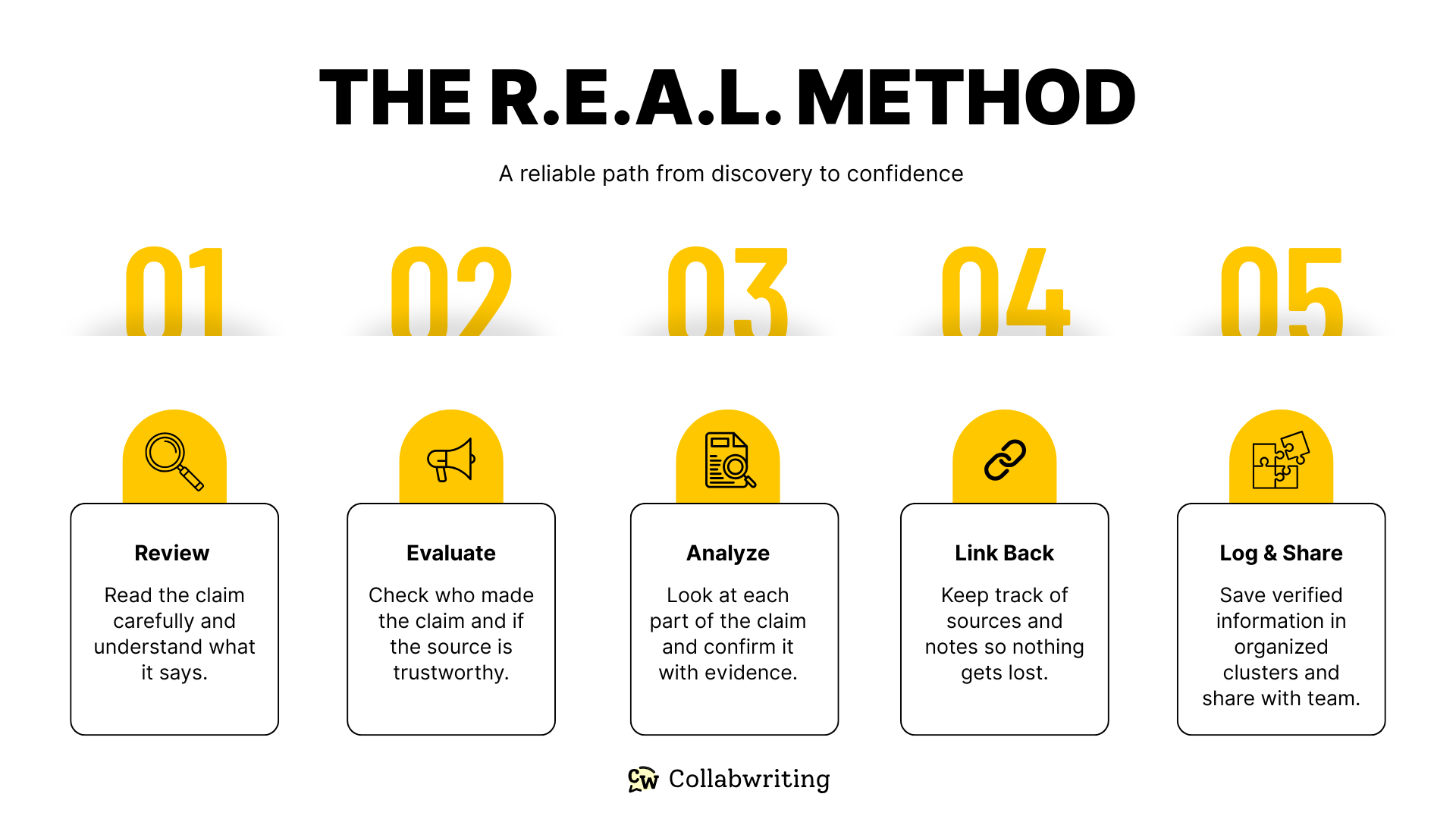
Step-by-Step Techniques to Verify Information Accurately
Knowing the workflow is one thing. Applying practical techniques makes verification effective.
Here’s how I approach it:
Cross-Referencing Sources to Build Credibility in Research
I compare the claim across multiple reputable sources. Finding original reports or primary evidence is key. When sources disagree, I investigate further to understand the difference.
Checking Source Credibility
I check who wrote the claim and where it was published.
I look for signs that the source is trustworthy, like a history of accurate reporting or a clear professional background. Knowing this gives me more confidence in the information.
Analyzing Biases
I consider whether a claim might be influenced by bias, marketing, or personal opinion. Noticing these patterns helps me judge the evidence more accurately and maintain credibility in my research.
Fact-Checking Websites and Tools
I cross-check claims with multiple reputable sources and original reports whenever possible.
I look for context, date, and author credibility to make sure the information is accurate. For multimedia content like images or videos, I verify authenticity by tracing its origin and checking for any signs of manipulation.
💡 Pro Tip: Organizing links, screenshots, and notes manually is time-consuming. Collabwriting allows you to capture highlights, add notes, and save sources in a structured way, so you can verify information and build credibility in research efficiently.
How Collabwriting Helps You Verify Information and Organize Sources
Collabwriting is more than a note-taking tool. It’s a research and verification platform that combines highlighting, source tracking, and collaboration in one workspace.
Capture Information Instantly in Collabwriting
When I find an article, PDF, or social post, I use the Collabwriting browser extension. I highlight sentences or paragraphs that matter, and each highlight automatically saves the original source.

Add Notes and Context to Build Credibility in Research
When I save a snippet, I add a short note explaining why it matters. This helps me remember the reasoning behind each highlight later.

I also use tags to categorize information by topic, claim, or project. This way, when I’m working on multiple research threads, I can quickly filter and find exactly what I need without scrolling through endless notes.

Organize Snippets into Clusters
I group related snippets into clusters so large research projects stay manageable.
For example, I might have clusters like “COVID-19 Facts”, “Marketing Statistics 2025”, or “Startup Research”. This makes it easy to see all the relevant information at a glance and prevents losing context across multiple sources.
Collaborate with Colleagues Efficiently
I @mention teammates to review snippets, add comments, or verify information.
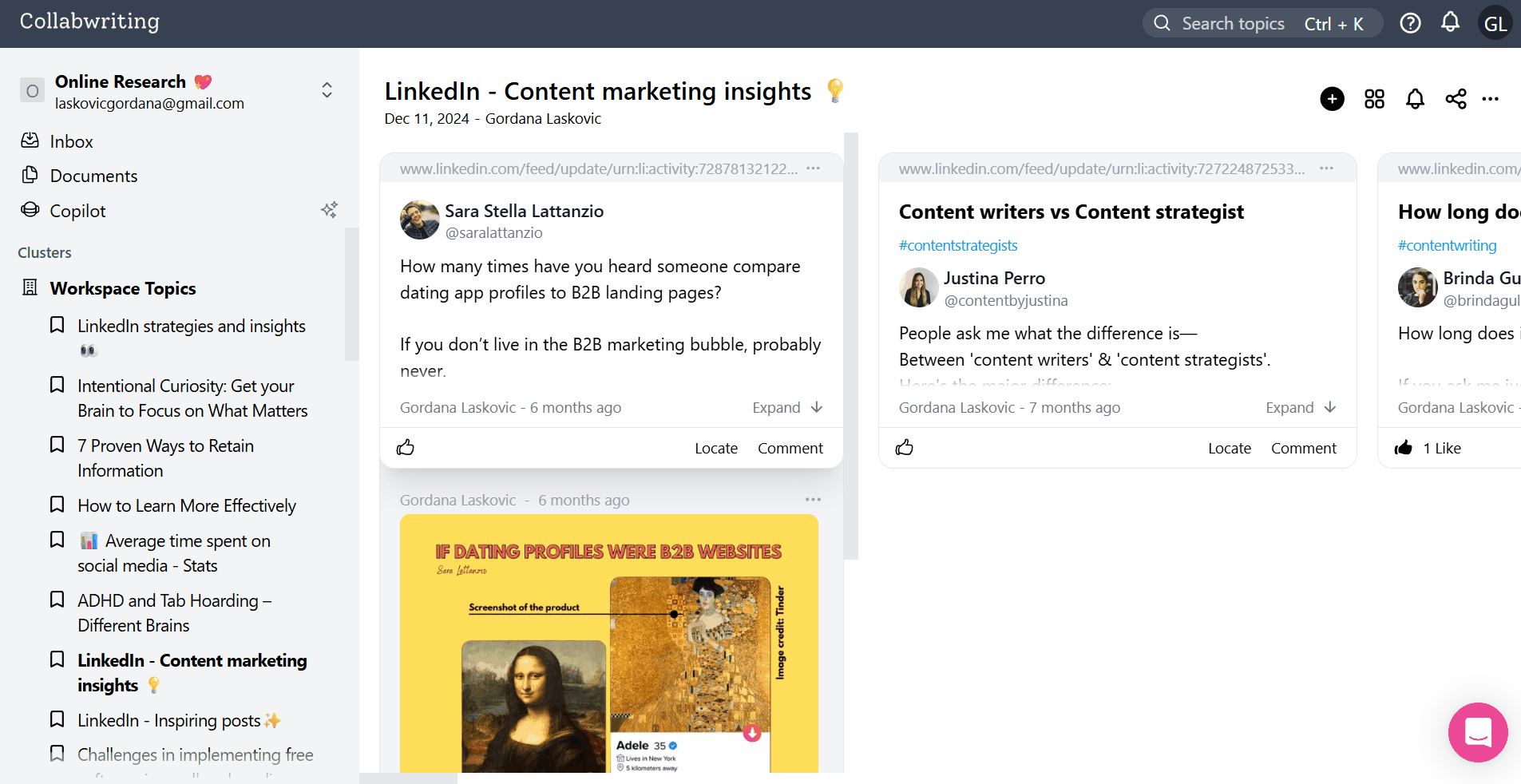
This is crucial when accuracy matters and multiple people need to check the same claims.
Integrate Chat Agents to Verify Information Faster
Collabwriting Chat provides AI agents that search for relevant sources quickly.
Once the AI suggests sources, I review, highlight, and save them into the right clusters. Then I ask teammates to double-check, comment, or expand on the information.
By using notes, clusters, collaboration, and Chat agents, I avoid losing sources, context, or insights. Everything stays structured and accessible, which makes verifying information easier and helps build credibility in research without the usual overwhelm.
Using Collabwriting's Chat Agents to Verify Information Faster
Finding sources efficiently is often the slowest part of verification. Collabwriting Chat helps by providing AI agents designed for specific research tasks.
To use it:
- Go to your Dashboard and click on Chat.
- Select an Agent depending on your research goal. Each Agent specializes in a type of search.
- Type your prompt and hit enter.
The AI instantly pulls relevant insights from both the web and your Collabwriting workspace. Each answer comes with source links, which I review, save in clusters, and share with colleagues for verification.
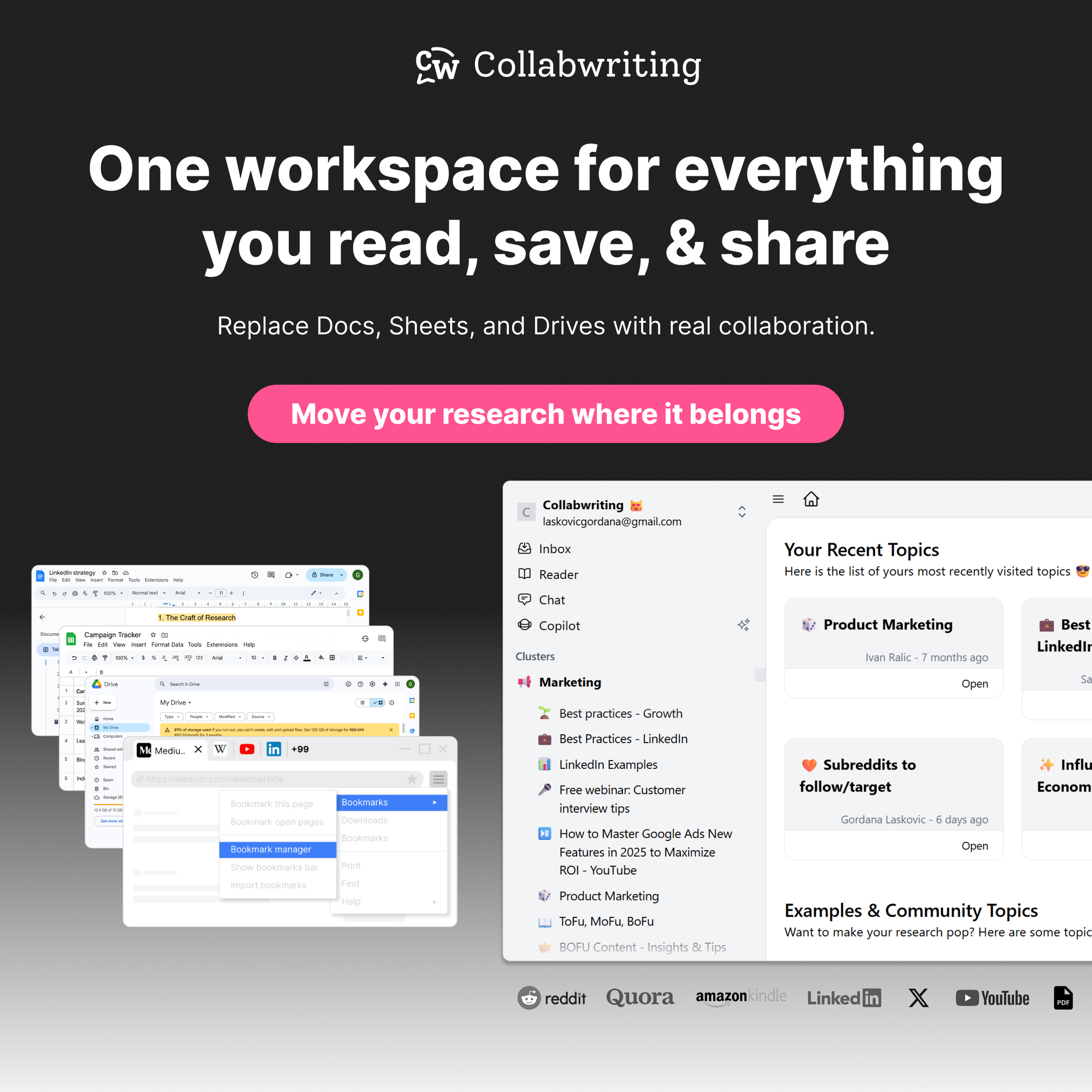
Collabwriting - Make Every Save Actionable
Collabwriting allows you to gather all your online sources in one place. Just highlight, save, and collaborate with anyone on any content you find online, including PDFs.
No more endless scrolling, no more lost insights, just simple, structured knowledge at your fingertips.
Source Tracking and Context: Build Credibility in Research with Collabwriting
Finding sources is only half the job. Maintaining the trail of context is crucial.
Every snippet has a story: original wording, date, author, and situation. Losing this context can make verification incomplete.
Collabwriting ensures highlights, notes, tags, and clusters stay connected to the original source. Chat agents speed up discovery, while collaboration ensures nothing slips through the cracks.
This system makes verification reliable, organized, and team-friendly.
Confidently Verify Information and Build Credibility in Research
Verifying information online is essential for credibility and peace of mind. By following the R.E.A.L. method, applying practical techniques, and leveraging Collabwriting with its Chat agents, you can confidently verify information online and build credibility in research.
With this workflow, you can close your laptop at sunset without that anxious “Did I forget something?” feeling. Verification becomes a process that builds confidence, supports collaboration, and keeps all information organized and context-rich.
🙌🏼 Ready to take control of your research? Try Collabwriting today - highlight, organize, and verify information like a pro, without the overwhelm.
FAQ
Why does verifying online information feel overwhelming?
Information moves fast online. Articles, social posts, and newsletters constantly appear, making it hard to track claims. Without a structured approach, fact-checking can feel scattered and exhausting.
What is the R.E.A.L. method in verification information?
The R.E.A.L. method is a step-by-step verification workflow:
- Review - Carefully read and understand the claim.
- Evaluate - Check the source, author, and date for credibility.
- Analyze - Break the claim into components and verify each.
- Link Back - Keep a clear trail of sources and notes.
- Log & Share - Organize verified information for future reference or team collaboration.
What practical techniques help verify information accurately?
- Cross-reference sources: Compare claims across multiple reputable sources.
- Check source credibility: Look for author expertise and publication reliability.
- Analyze biases: Identify potential marketing, personal, or ideological biases.
- Use fact-checking tools: Verify context, dates, and multimedia authenticity.
How does Collabwriting help with verification?
Collabwriting allows you to:
- Highlight and save relevant content instantly with source tracking.
- Add notes explaining why a snippet matters.
- Organize snippets into clusters for topics, claims, or projects.
- Collaborate with teammates using @mentions, comments, and shared clusters.
- Integrate Chat agents to quickly discover relevant sources and accelerate research.
What are the benefits of using Collabwriting for teams?
- Keeps all research, context, and insights in one structured place.
- Reduces lost sources and duplicated effort.
- Enables faster, confident fact-checking with collaboration.
- Helps maintain credibility and reduces anxiety over missed information.
How do Chat agents improve the verification process?
- Collabwriting Chat agents search for relevant sources across the web and your workspace, providing instant insights with source links. Teams can then review, save, and verify them collaboratively.
How can I stay organized and avoid losing context?
Use clusters, tags, and notes to categorize research by topic, claim, or project. Collabwriting ensures each snippet keeps its original source, date, and reasoning intact for reliable verification.
What’s the ultimate benefit of a structured verification workflow?
Following the R.E.A.L. method and using tools like Collabwriting turns verification into a calm, confident process. You can close your laptop knowing your research is thorough, accurate, and credible.



![Build Credibility in Research: Smart Way to Verify Information and Track Sources Easily [2025]](/content/images/2025/10/covers-for-blog--7--1.png)

![5 Tools Marketers Use to Organize Research - Compared [2025]](/content/images/2025/11/cover-4-1.png)

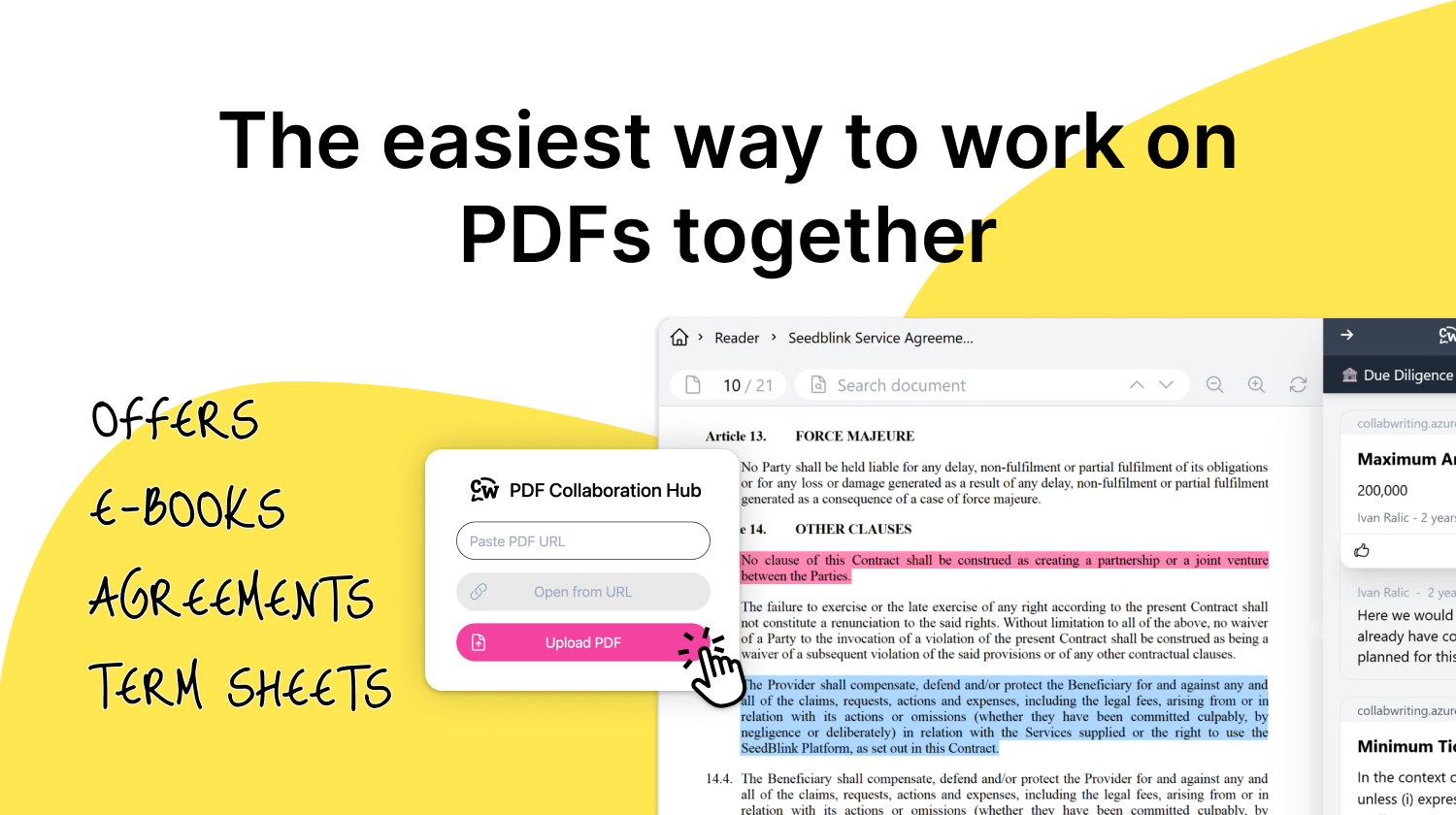
![How Marketers Can Turn LinkedIn Content into Collaborative Research [2025]](/content/images/2025/10/covers-for-blog--8-.png)
![Best Readwise Alternative for Personal & Team Research [2025]](/content/images/2025/09/Frame-814--3-.png)
